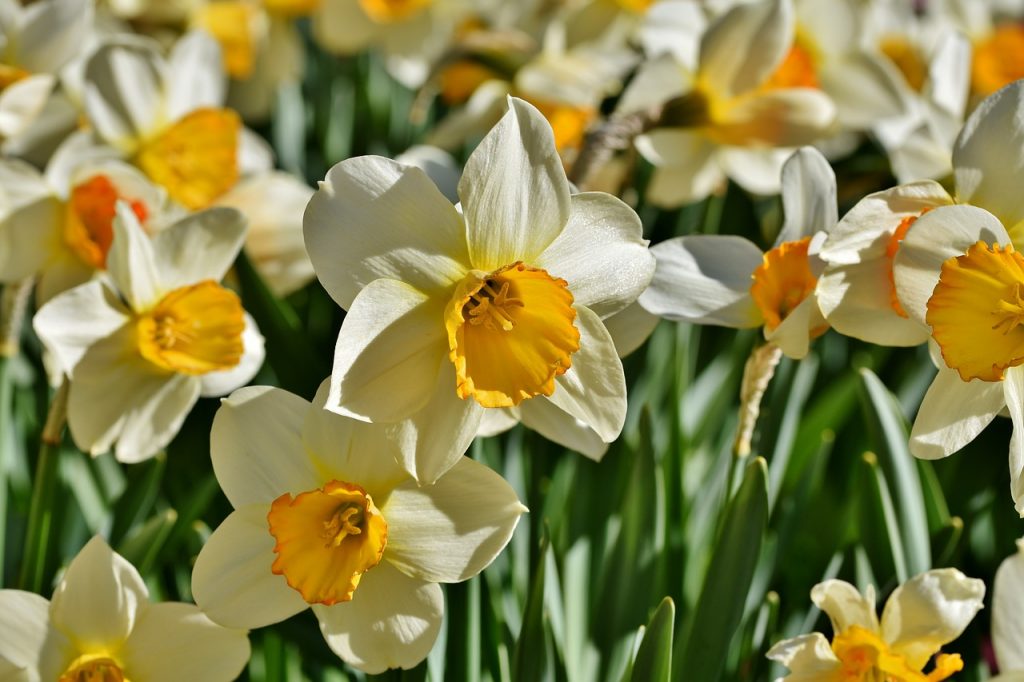The history and culture of narcissus is a fascinating subject that delves into the origins and significance of this beautiful flower in human history. Narcissus, also known as daffodil, has a rich heritage that spans across different civilizations and cultures. It has been cultivated and admired for centuries, captivating the hearts of people with its vibrant colors and delicate fragrance.
In ancient times, narcissus was highly valued for its medicinal properties and was used in various remedies. Its bulbs were believed to have healing powers and were used to treat ailments such as respiratory problems and digestive disorders. The flower’s beauty and fragrance also made it a popular choice for decorative purposes, adorning gardens and homes with its vibrant presence.
Narcissus holds a special place in Greek mythology, where it is associated with the story of Narcissus, a young man who fell in love with his own reflection in a pool of water. This tale symbolizes self-love and vanity, and the flower itself is often seen as a representation of beauty and self-reflection.
The symbolism of narcissus extends beyond Greek mythology and has found its way into various art forms and literature. Paintings and sculptures throughout history have depicted the flower as a metaphor for beauty and self-obsession. It has also been a source of inspiration for poets and writers, who have used its imagery to explore themes of introspection and self-discovery.
Today, narcissus continues to be a beloved flower with cultural significance in many societies. Its vibrant blooms are often associated with the arrival of spring and are celebrated in festivals and traditions around the world. In China, for example, narcissus is a symbol of good luck and prosperity, often displayed during the Chinese New Year festivities. In Iran, the flower is a prominent feature of the Persian New Year celebration, symbolizing rebirth and renewal.
Overall, the history and culture of narcissus are deeply intertwined with human civilization. Its origins, symbolism, and cultural representations all contribute to its enduring popularity and significance in various societies. Whether admired for its beauty, cherished for its symbolism, or appreciated for its cultural traditions, narcissus continues to captivate and inspire people around the world.
Origins of Narcissus
The origins of narcissus can be traced back to ancient civilizations, where it was cultivated and revered for its beauty and fragrance. This stunning flower has a rich history that spans across different cultures and time periods, making it a fascinating subject of study.
In ancient Greece, narcissus held a special place in mythology, particularly in the story of Narcissus himself. According to the myth, Narcissus was a handsome young man who fell in love with his own reflection in a pool of water. Unable to tear himself away, he eventually wasted away and transformed into the flower we now know as narcissus.
Throughout history, narcissus has been cultivated and cherished for its aesthetic appeal. It has been depicted in various forms of art, including paintings and sculptures, where it often symbolizes beauty, self-reflection, and the transient nature of life. In literature, narcissus has been used as a metaphor for introspection and self-love.
In modern times, narcissus continues to captivate people’s attention. Its cultivation has expanded to different parts of the world, and it has become a popular flower in gardens and floral arrangements. Additionally, the concept of narcissism, derived from the myth of Narcissus, has gained psychological significance and is often associated with self-centeredness and excessive self-love.
From its ancient origins to its contemporary significance, narcissus remains a symbol of beauty, self-reflection, and the delicate balance between vanity and introspection. Its history and cultural representations offer a glimpse into the human fascination with this remarkable flower.
Narcissus in Mythology
In Greek mythology, narcissus holds a significant role and is often associated with the concept of self-love and vanity. The myth of Narcissus tells the story of a young man who was exceptionally beautiful and became infatuated with his own reflection. According to the myth, Narcissus was so captivated by his own image that he could not tear himself away from it, eventually wasting away and transforming into the narcissus flower.
This myth serves as a cautionary tale about the dangers of excessive self-love and vanity. It highlights the destructive consequences that can arise from being consumed by one’s own beauty and self-obsession. The narcissus flower, with its delicate petals and vibrant colors, has become a symbol of this self-reflective and self-absorbed nature.
Narcissus in Art and Literature
The depiction of narcissus in art and literature has been a recurring theme throughout history, capturing the fascination of artists and writers alike. In paintings, narcissus is often portrayed as a delicate and alluring flower, symbolizing beauty and self-reflection. Artists use vibrant colors and intricate details to bring the narcissus to life on canvas, showcasing its ethereal qualities.
Sculptures also pay homage to the narcissus, with artists crafting intricate and lifelike representations of the flower. These sculptures often serve as a testament to the beauty and fragility of the narcissus, capturing its essence in a three-dimensional form. Whether carved from stone or molded from clay, these sculptures evoke a sense of awe and admiration.
In literature, the narcissus is frequently used as a metaphor for beauty and self-reflection. Writers draw upon the flower’s captivating qualities to explore themes of vanity, introspection, and the pursuit of one’s own image. Through poetry, novels, and plays, the narcissus becomes a powerful symbol that resonates with readers, inviting them to contemplate their own sense of self.
Overall, the depiction of narcissus in art and literature serves as a testament to the enduring fascination with this enchanting flower. It invites us to appreciate its beauty, contemplate our own reflection, and explore the complexities of human nature.
Narcissus in Contemporary Culture
Narcissus in Contemporary Culture
In today’s society, narcissus holds a significant influence and cultural significance, particularly in the realms of social media, self-image, and narcissistic personality traits. The rise of social media platforms has provided a breeding ground for narcissistic behavior, as individuals strive to present an idealized version of themselves to gain validation and admiration from others. The constant need for attention and validation on social media platforms can lead to the development of narcissistic personality traits.
Moreover, the obsession with self-image and physical appearance has become increasingly prevalent in contemporary culture. The emphasis on beauty standards and the pressure to conform to societal ideals often fuels narcissistic tendencies. The desire for perfection and constant self-evaluation can lead individuals to become excessively self-absorbed and preoccupied with their own appearance.
It is important to recognize the impact of narcissus in contemporary culture and the potential negative consequences it can have on individuals’ mental well-being. The obsession with self-image and the pursuit of validation through social media can contribute to feelings of inadequacy, low self-esteem, and a distorted sense of self-worth. It is essential to promote healthy self-esteem and encourage individuals to focus on their inner qualities and personal growth rather than external validation.
Narcissus in Different Cultures
Narcissus in Different Cultures
In different cultures around the world, narcissus holds a significant place and is often associated with various traditions and symbolism. Let’s take a closer look at how narcissus is perceived and valued in countries like China, Iran, and ancient Egypt.
China:
In Chinese culture, narcissus, also known as the “Water Fairy Flower,” is highly regarded for its beauty and symbolism. It is considered a symbol of good fortune, prosperity, and purity. The Chinese people often use narcissus as a decorative element during the Chinese New Year celebrations, believing that it brings luck and blessings for the upcoming year.
Iran:
In Iran, narcissus, locally known as “Nargis,” has deep cultural significance and is associated with the Persian New Year, known as Nowruz. During this celebration, Iranians display narcissus flowers as a symbol of rebirth and renewal, representing the arrival of spring and the start of a new year. The delicate fragrance of narcissus fills the air, creating a joyful and festive atmosphere.
Ancient Egypt:
In ancient Egypt, narcissus held a special place in their mythology and religious practices. The flower was associated with the goddess Isis, who was believed to be the mother of all pharaohs. Narcissus was considered a symbol of fertility, beauty, and the cycle of life and death. It was often depicted in ancient Egyptian art and used in rituals and ceremonies.
In conclusion, narcissus has deep cultural significance and symbolism in various traditions and societies. From China’s belief in its luck-bringing properties to Iran’s association with the Persian New Year and ancient Egypt’s connection to mythology, narcissus continues to captivate and inspire people around the world.
Narcissus Festivals and Traditions
Narcissus Festivals and Traditions are vibrant celebrations that revolve around the cultivation and appreciation of narcissus flowers. One such festival is the Narcissus Festival in Taiwan, which takes place every year during the blooming season of the flower. This festival showcases the beauty and fragrance of narcissus through various exhibitions, performances, and competitions. Visitors can admire stunning displays of narcissus flowers, participate in flower arrangement contests, and learn about the history and cultivation techniques of this beloved flower.
Another notable celebration is the Persian New Year, also known as Nowruz, which includes the tradition of growing narcissus flowers. In Persian culture, these flowers symbolize rebirth and the arrival of spring. During the New Year festivities, families often grow narcissus bulbs in shallow dishes filled with water and pebbles. As the flowers bloom, they bring a sense of joy and renewal to households.
Narcissus as a Symbol
Narcissus, the beautiful and delicate flower, holds deep symbolic meanings in various cultures around the world. It is often associated with concepts such as rebirth, renewal, and the fragility of life. Let’s delve into the rich symbolism of narcissus and explore how it is interpreted in different societies.
In many cultures, narcissus is seen as a symbol of rebirth and renewal. Its emergence from the cold, barren earth in early spring represents the awakening of nature and the start of a new cycle of life. The vibrant yellow or white petals of the narcissus flower are reminiscent of the sun, symbolizing warmth, light, and the return of vitality after the long winter months.
Furthermore, narcissus is often regarded as a symbol of fragility and transient beauty. The flower’s short blooming period, which lasts only a few weeks, serves as a reminder of the ephemeral nature of life. Just like the delicate petals of the narcissus wither and fade, human existence is also fleeting and impermanent. This symbolism encourages us to cherish and appreciate the beauty and preciousness of life while it lasts.
The symbolic meanings attributed to narcissus may vary across different cultures. In some traditions, narcissus is associated with purity and innocence, representing the untouched and uncorrupted aspects of the human soul. In others, it is seen as a symbol of self-love and self-reflection, reminding individuals to take care of their own well-being and nurture their inner selves.
Overall, narcissus serves as a powerful symbol that resonates with the universal themes of rebirth, renewal, fragility, and self-reflection. Its beauty and symbolism have captivated artists, writers, and thinkers throughout history, inspiring them to explore these profound concepts in their works. By understanding the cultural significance of narcissus, we gain a deeper appreciation for the intricate tapestry of human beliefs and the profound connections between nature, art, and the human experience.
Narcissus in Psychology
Narcissus in Psychology is a fascinating subject that delves into the psychological concept of narcissism and its connection to the myth of Narcissus. In Greek mythology, Narcissus was a young man who fell in love with his own reflection in a pool of water, ultimately leading to his demise. This myth serves as a metaphor for excessive self-love and vanity, which are key characteristics of narcissism.
In the field of psychology, narcissism refers to a personality trait characterized by an inflated sense of self-importance, a constant need for admiration, and a lack of empathy for others. Individuals with narcissistic traits often have an exaggerated sense of their own abilities and achievements, seeking constant validation and attention from others.
The myth of Narcissus provides a powerful symbol for understanding narcissistic personality disorders, which are characterized by a pervasive pattern of grandiosity, a need for admiration, and a lack of empathy. People with narcissistic personality disorders often have fragile self-esteem and are highly sensitive to criticism or perceived slights.
Understanding the psychological concept of narcissism and its connection to the myth of Narcissus can shed light on the complex nature of personality disorders and provide insights into effective therapeutic approaches. By exploring the origins and implications of narcissism, psychologists and mental health professionals can develop strategies to help individuals with narcissistic traits lead more fulfilling and balanced lives.
Narcissus Conservation and Preservation
Efforts to protect and preserve narcissus species have become increasingly important as these beautiful flowers face numerous conservation challenges. One of the main threats to narcissus is habitat loss. As human populations expand and urbanization encroaches on natural areas, the natural habitats where narcissus grow are being destroyed. This loss of habitat not only threatens the existence of narcissus but also impacts the entire ecosystem they are a part of.
In addition to habitat loss, climate change poses another significant challenge to narcissus conservation. As temperatures rise and weather patterns become more unpredictable, narcissus populations can be negatively affected. Changes in rainfall patterns, for example, can disrupt the natural growth and blooming cycles of narcissus. Extreme weather events such as droughts or floods can also have a devastating impact on these delicate flowers.
To address these conservation challenges, various organizations and individuals are working towards the protection and preservation of narcissus species. Conservation efforts include the establishment of protected areas and nature reserves where narcissus can thrive undisturbed. These areas not only provide a safe haven for the flowers but also help to protect the biodiversity of the surrounding ecosystems.
Furthermore, initiatives are being undertaken to raise awareness about the importance of narcissus conservation and the need to protect their natural habitats. Education and outreach programs aim to engage the public and promote sustainable practices that minimize the negative impact on narcissus populations and their habitats.
In conclusion, the conservation and preservation of narcissus species are crucial for their survival and the overall health of the ecosystems they inhabit. Efforts to protect these flowers from habitat loss and the effects of climate change are essential to ensure their continued existence for future generations to enjoy.
Frequently Asked Questions
- What is the significance of narcissus in human history?
Narcissus holds a rich historical significance, dating back to ancient civilizations. It has been cultivated and admired for its beauty and fragrance for centuries, symbolizing rebirth, renewal, and the fragility of life.
- How is narcissus portrayed in Greek mythology?
In Greek mythology, narcissus is known for the story of Narcissus, a handsome young man who fell in love with his own reflection in a pool of water. This tale represents the concept of self-love and vanity, cautioning against excessive self-absorption.
- What role does narcissus play in art and literature?
Narcissus has been a popular subject in various art forms. It has been depicted in paintings and sculptures, often symbolizing beauty and self-reflection. In literature, narcissus is frequently used as a metaphor for introspection and self-discovery.
- How does narcissus relate to contemporary culture?
Narcissus has found its place in contemporary culture, especially with the rise of social media and the emphasis on self-image. It reflects the influence of narcissistic personality traits and the constant pursuit of validation and attention.
- What is the cultural significance of narcissus in different societies?
Narcissus holds cultural significance in various traditions around the world. In China, it is associated with good fortune and prosperity. In Iran, it symbolizes the arrival of spring during the Persian New Year celebration. Ancient Egyptians considered it a symbol of resurrection and eternal life.
- Are there any festivals or traditions related to narcissus?
Yes, there are several festivals and traditions associated with narcissus. For instance, Taiwan celebrates the Narcissus Festival, showcasing beautiful displays of narcissus flowers. During the Persian New Year, Iranians display narcissus as part of their traditional Haft-Seen table.
- What is the connection between narcissus and psychology?
The concept of narcissism in psychology draws inspiration from the myth of Narcissus. It refers to excessive self-admiration, a preoccupation with one’s own abilities, and a lack of empathy for others. Narcissistic personality disorder is a psychological condition characterized by an inflated sense of self-importance.
- How is narcissus conservation being addressed?
Efforts are being made to protect and preserve narcissus species. Conservation initiatives focus on addressing habitat loss, climate change, and promoting sustainable cultivation practices. These endeavors aim to ensure the survival of various narcissus species for future generations.



